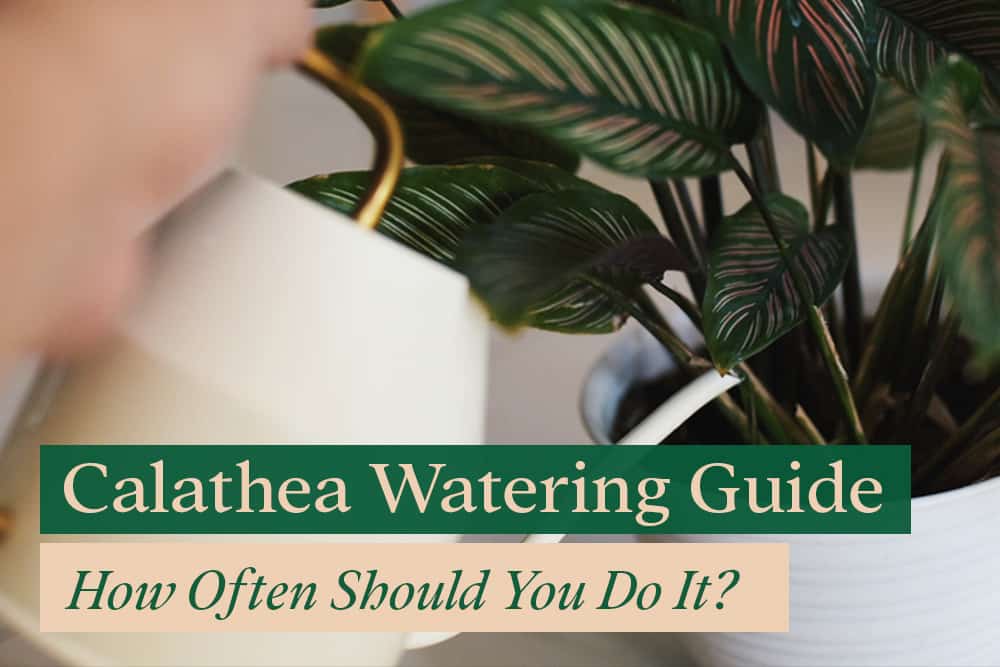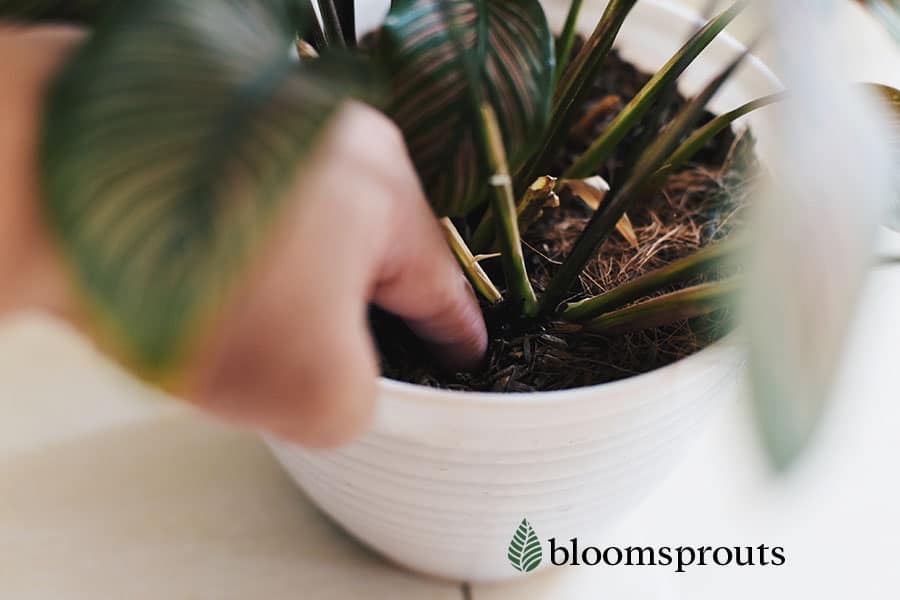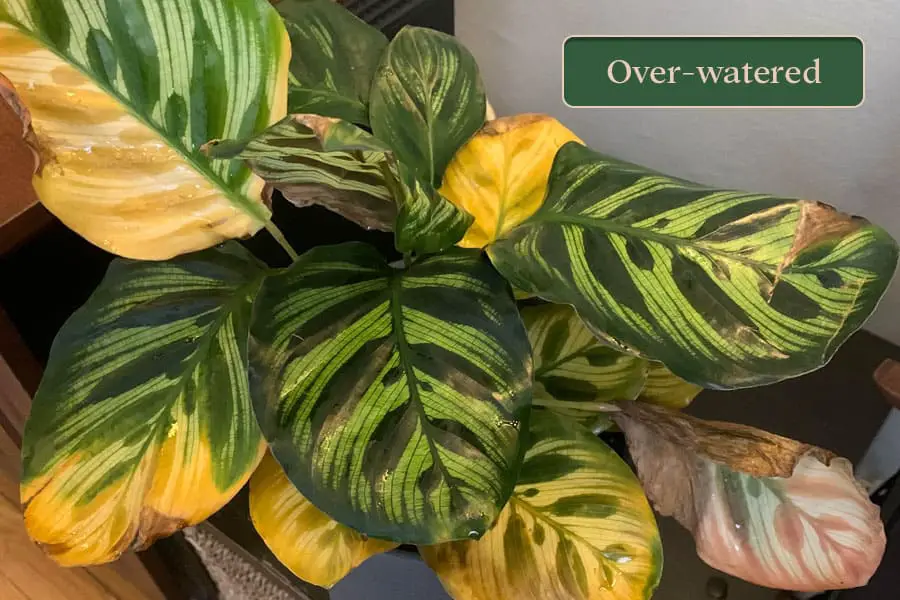
Calathea is sensitive to both overwatering and underwatering, so its watering schedule will need to reflect that. These plants tend to be fussy about water; you will need to pay close attention to how your Calathea reacts to different conditions and adjust accordingly.
You should water your Calathea when the top two inch of the soil is dry. In general, you will need to water them once a week. However, in colder climates or low light levels, you should wait at least 2 weeks before watering.
In this article you will also learn the different factors that will impact the amount of water your Calathea needs and watering tips to make sure they thrive!
Let’s get started!
When to water Calathea
As a rule of thumb, your calathea will need to be watered every week or anytime the top 2 inch of the soil in the pot has dried up.
But, the exact timing will vary depending on many factors such as soil quality, drainage and how quickly the plant has been absorbing water. Calathea likes their soil to be moist but not soggy.
So how to make sure you don’t go underwater or overwater? Don’t worry, It will tell you when it’s thirsty, but you have to pay attention.
Here is how to tell if your Calathea need watering:
- The Finger Test

To determine if your calathea is ready to be watered, stick your finger into the soil.
If you feel that the top 2 inches of the soil is still damp, the plant is not ready for more water. However, if the soil feels mostly dry, it is time to water your calathea with distilled or purified water.
- Using a Soil Meter
Alternatively, you can use a soil meter to get a more accurate reading of the soil condition. Simply insert its probe at least 4 to 6 inches into the soil and if the reading shows between 1 to 3, then it is time to water your Calathea.
After watering, make sure to dump out any extra water that may pool in the drainage tray. Leaving your calathea in standing water can lead to root rot.
Watering During Summer vs Winter
Calathea is a tropical plant, so it thrives in the summer when it is sunny and warm. In the winter, its growth will slow and it will need to be watered less frequently.
In Summer
During the summer, you should be able to water your calathea as often as once a week. The increased light and warmth during the summer will lead your calathea to grow more and use more water.
More light generally means more growth, but you will want to be careful that you don’t expose your calathea to too much bright light. Direct light or even bright, indirect light will be too much for this plant and may cause burning or wilting of its leaves.
Also read: Calathea Light Requirements – How Much Does it Need?
In Winter
In the winter, your calathea’s growth will slow down and it will not need as much water. You should be able to cut back its watering schedule to once every two weeks.
You will want to pay extra attention to your calathea’s water needs during these periods of dormancy by checking the soil moisture often. If you are struggling to gauge the soil moisture properly, purchasing a moisture meter to keep in your calathea’s soil would be a good investment. This will tell you at a glance if the plant needs water or not.
Other things to watch out for in the winter that will affect how much water your calathea needs include the humidity and changing temperature, which we’ll discuss a little further down.
Underwatered Calathea

As tropical plants, calathea respond poorly to dry conditions, and they should never be left to dry out completely. Chronic underwatering will cause your calathea to dry up and slow down its growth.
Signs your Calathea is Underwatered
Droopy and curling leaves are early signs of underwatered Calatheas. When left dry for too long, the leaves may begin to turn yellow or crispy brown at the tips and edges.
When these signs develop, a good practice is to give your Calathea a good watering until you observe water came out of the drainage holes.
Always check its soil before watering to make sure it is dry. A calathea’s natural leaf movement throughout the day can sometimes be mistaken for thirsty drooping.
How to avoid Under-watering a Calathea
Forgetting to water your calathea on time every once in a while is fine, but if your calathea is consistently underwatered, it will start to become distressed. The leaves will turn yellow and crispy.
To avoid chronic underwatering, here are a few tips to consider:
- Water more frequently. Test moisture levels in the soil regularly with your finger or a moisture meter to become familiar with when your calathea wants to be watered.
- Check the soil quality. Very old soil will not hold onto moisture as well. Also soil that has been allowed to dry out completely will tend to repel water.
- Does it need a new pot? A plant that has outgrown its pot will dry out quickly. If the pot size is okay, perhaps it needs a different material. Terra cotta or clay pots wick moisture away from the soil, while plastic and glazed pots will hold moisture in longer.
- Use self watering pot if you tends to miss its watering schedule.
Also Read: How Long Can Plants Go Without Water?
Overwatered Calathea
Overwatering your calathea can happen easily, as they are very picky and do not like “wet feet.” It is easy to mistake Calathea’s daily leaf movement up and down with the sun as a sign that it is thirsty. This is why we use the soil, rather than the leaves, as our guide.
Signs of Overwatering in Calathea

Left in soggy soil, your calathea will rapidly develop yellow leaves. Its petioles (leaf stems) may become droopy, and the soil may develop a mold or fungus on top.
Over time, this may develop into root rot. Verify root rot by removing your Calathea from its pot and inspecting the root.
The roots should be firm and yellowish. If they are mushy and brown or black, your plant is suffering from root rot. Remove all the old soil and dead roots and repot into a sterilized pot with fresh potting soil.
How to avoid Overwatering a Calathea
Avoid overwatering your calathea by checking moisture levels before watering it. Do not mistake its daily leaf movement for droopiness.
You can tell the difference by looking at the petioles. As long as the leaf stem is still standing upright, you can be assured that its droopy-looking leaf is just following the sunlight.
If you have a tendency to overwater your plants in general, you should consider introducing better drainage for your calathea. Mixing more sand and perlite into the soil will allow the soil to drain better, and a terra cotta pot will wick away extra moisture.
Other factors affecting the need of water
There are lots of factors that will affect your calathea’s water needs. You should keep these in mind, because your plant will need more or less water if any of these conditions changes.
Light Level
When calathea receives lots of light—up to medium indirect light—it will need more water, as it will be growing more. In contrast, if your calathea is in a darker room or gets less sun because of winter time, its growth will slow down, and therefore it will need less water.
Humidity
Calatheas love humidity! This is natural for them, as they are jungle plants. When your calathea is exposed to enough moisture in the air, it will be very happy. If your home’s humidity is low, your calathea’s leaves may become crispy on the edges, and the plant will need a little extra water.
Ideally, Calathea prefers humidity levels between 50% to 60%. During the winter, you might need a humidifier to increase the humidity.
Also Read: Everything you Need to Know Before Buying a Humidifier
Temperature
Calatheas are very sensitive to temperature. They don’t like cold air or cold water. Their growth will slow when the ambient temperature drops below 60°F, and when they’re not growing, they won’t need as much water.
Also Read: Do Watering Plants in the Sun Cause Leaves to Burn?
Soil Mix
Your calathea’s soil mix will have an effect on how often you need to water it. Soil with a higher concentration of sand or perlite will have lots of drainage, so you will need to water more often. Soil heavy in organic matter will hold onto moisture, so you will need to water less often.
Pot Type
The kind of pot your calathea is in will also affect how often you need to water it. Pots made of porous materials like clay, terra cotta, or wood will wick moisture away from the soil. This is great to help prevent overwatering, but you will need to pay close attention to make sure your calathea does not dry out too quickly.
Non-porous pot materials include plastic and glazed clay. These materials will keep moisture in the pot. Calatheas will generally prefer these materials because they like their soil to be a little bit on the moist side.
Always make sure your calathea’s pot has at least one drainage hole in the bottom! If you really want to use a pot that has no drainage, you should keep your calathea in a plastic nursery pot and place it inside the decorative hole-less pot.
Related questions
What Type of Water is Best for Calathea?
Calatheas are sensitive to the different minerals and chemicals found in tap water, especially hard water. The best water for your calathea is distilled or filtered water. Rainwater is also a good choice.
If you must use tap water, let it air out for 24 hours before using it so that the chlorine can evaporate. This will also allow the water to come to room temperature so that it does not shock your calathea’s roots.
Should You Mist Calathea?
Your calathea loves humidity! However, misting is not a great way to improve humidity for any houseplant. It only provides benefits for about 30 minutes. Also, water left on the leaves overnight can cause fungal issues.
If you want to increase the humidity for your calathea, my best recommendation would be to get a small humidifier and place it nearby. Clustering plants together will also provide them a slight increase in humidity as they release moisture from their leaves.
